Learn helpful tips to decide what kind of bed your kid should have. Discover what size bed is right for your child, from mattress size to weight limitations.
Are you struggling to determine the best bed size for your child? Are their comfort and well-being currently at stake? When the transition to a bigger bed can be daunting. Not to mention the practical considerations like room size and layout.
I understand the worries that come with making these decisions. As a father of two, I’ve been there. We all want to give our children the best sleeping environment. Ensuring they wake up refreshed and ready to take on the world. But how do we know we’re making the right choice?
That’s why I’m here to help you navigate this adventure.
This guide will cover the ideal bed size for:
- Newborn to Infant Stage (0-12 months)
- Toddler Stage (1-3 years
- Preschool Age (3-5 years
- School-Age Children (6-12 years)
- Teenagers (13-19 years)
Select your kid’s age, and let’s go over the ideal bed option!
Uncertain about which mattress to get? Take a look at this list of the best kid’s mattresses. I have put lots of hours into this guide, and you’ll find the ideal mattress for your child!
Newborn to Infant Stage – 0 to 12 months: The Tiny Sleepers
It seems like only yesterday when my kids were just little babies. Babies sleep a lot in their first year of life, so we want them to be as comfy as possible. These bed options ensure your baby is safe and comfortable from day one.
What Type of Bed is Suitable for Newborns and Infants?
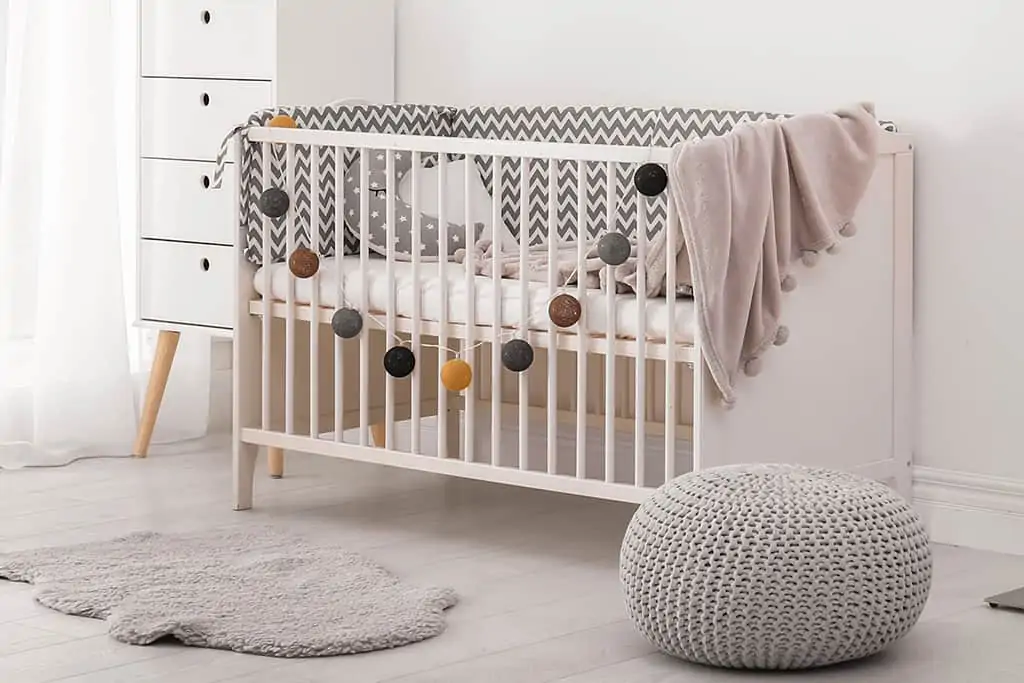
Cribs
Cribs are the most popular option because they provide a safe and secure sleep environment. Look for cribs that meet the latest safety standards and have a firm mattress to support your baby’s body.
- Size: Standard crib dimensions are 28 x 52 inches.
- Age suitability: Suitable from birth until 2-3 years, depending on the child’s size and mobility.
- Size and weight limits: Most cribs can hold up to 50 pounds.
For more information on cribs, check out this guide I created to help you choose the best crib for your baby.
Bassinets
Bassinets are compact and portable, making them ideal for parents who want their baby close by during the first few months.
- Size: Typically 16-20 inches wide and 30-34 inches long.
- Age suitability: Suitable for newborns and young babies up to 4-5 months old.
- Size and weight limits: Most bassinets have a weight limit of 15-20 pounds.
Co-sleepers or Bedside Sleepers
Co-sleepers allow babies to sleep close to their parents while maintaining a separate, safe sleep space.
- Size: Varies by model, but usually around 19 x 34 inches.
- Age suitability: Suitable for newborns and young babies up to 6 months old.
- Size and weight limits: Weight limits vary by model, typically around 20-30 pounds.
Moses Baskets
Moses baskets are lightweight and portable but have a limited lifespan due to babies quickly outgrowing them.
- Size: Around 30 x 16 inches.
- Age suitability: Suitable for newborns and young babies until they can roll over or sit up.
- Size and weight limits: Usually recommended for babies up to 15-20 pounds.
Safety is always the top priority when choosing a bed for your newborn.
How to Ensure Safety and Comfort for Your Baby
- Firm Mattress: A firm mattress supports your baby’s delicate body and reduces the risk of SIDS (Sudden Infant Death Syndrome). Invest in a high-quality mattress, like the Newton Baby Crib Mattress, that meets safety standards and fits your baby’s bed snugly.
- Safe Sleep Environment: Keep the crib clutter-free to minimize the risk of suffocation. No pillows, blankets, or stuffed animals. Use a fitted sheet specifically designed for your baby’s bed. One of my favorite hacks is to use a sleep sack to keep your baby warm without loose bedding.
- Room Temperature: Keep the room temperature between 68-72°F (20-22°C) for optimal comfort and safety.
- Monitor Your Baby: Consider using a baby monitor to keep an eye (and ear) on your little one while they sleep. My favorite baby monitor is the Nanit. Besides the quality video and audio, this baby monitor tells you the temperature in your baby’s room.
Consider factors like your baby’s age, size, and the available space in your home to make an informed decision. My wife and I opted for a convertible crib for our firstborn, which saved us money in the long run as it grew with our child.
Remember, safety comes first!
Toddler Stage – 1 to 3 years: They Growing Up So Fast
As our little ones grow into curious toddlers, their sleep needs change too. It’s time to consider transitioning to a bed suitable for their newfound mobility and independence. These beds are typically lower to the ground, making it easier for our little explorers to climb in and out. Plus, they come with guardrails to prevent those dreaded middle-of-the-night tumbles.
It’s an exciting adventure for both you and your child!
What Type of Bed is Suitable for Toddlers?
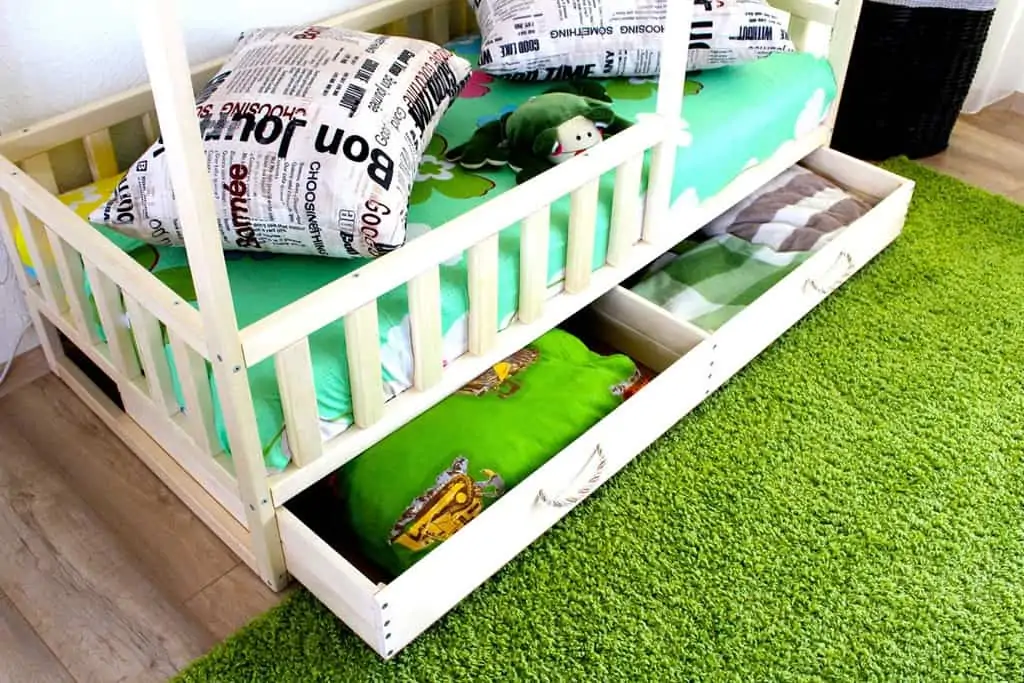
Toddler Beds
Low to the ground with built-in safety rails to prevent falls. Many toddler beds come in fun themes to make the transition more exciting.
- Age suitability: Designed for kids aged 1-3 years old.
- Size and weight limits: Uses a crib-sized mattress (28 x 52 inches) and can typically hold up to 50 pounds.
For more information on toddler beds, check out this guide I created to help you choose the best bed for your toddler.
Convertible Cribs
A budget-friendly option if you already have a convertible crib. Provides familiarity and consistency for your child during the transition.
- Age suitability: Suitable for kids aged 1-3 when converted into a toddler bed.
- Size and weight limits: Uses a crib-sized mattress (28 x 52 inches) and can hold up to 50 pounds.
For more information on convertible cribs, check out this guide I created to help you choose your child’s best crib.
Twin or Full-Size Beds
A long-term investment that your child can continue using well into their teenage years.
- Age suitability: Suitable for kids aged 1-3 when using safety rails.
- Size and weight limits: Twin beds are 38 x 75 inches, and full-size beds are 54 x 75 inches. Weight limits vary depending on the bed frame and mattress.
Platform Bed
When choosing a toddler platform bed, prioritize safety features like built-in guardrails and consider a lower height for easy access. Opt for a bed that complements your child’s interests and room decor while offering space-saving storage options. Lastly, consider beds that grow with your child to save money and effort in the long run.
- Age suitability: Platform beds for toddlers are typically suitable for children aged 2 to 5. However, this can vary depending on the child’s development and comfort level transitioning from a crib or toddler bed.
- Size and weight limits: Usually, these beds accommodate crib-sized or twin-sized mattresses, with weight limits ranging between 50-200 pounds.
House Bed
A house-shaped frame adds a fun and imaginative element to your child’s room.
- Age suitability: Suitable for kids aged 2 years and older.
- Size and weight limits: Usually available in twin or full-size dimensions. Weight limits vary depending on the bed frame and mattress.
For more information on house-shaped beds, check out this guide I created to help you choose the best house bed for your kid.
Montessori Floor Beds
Promotes independence and freedom of movement, as the mattress lies directly on the floor without a frame.
- Age suitability: Suitable for kids aged 1-3 years old.
- Size and weight limits: Typically available in twin or full-size dimensions. Weight limits vary depending on the bed frame and mattress.
I remember the excitement of setting up my kids’ new beds and watching them proudly settle into their updated sleep spaces. Enjoy the journey of finding the perfect bed for your growing little explorer!
When to Transition from a Crib to a Toddler Bed?
Knowing when to transition your toddler from a crib to a bed can be challenging. Generally, the transition occurs between 1.5-3.5 years old. It’s essential to look for signs of readiness, such as climbing out of the crib. Perhaps your child is becoming too tall for it or expressing interest in a “big kid” bed. Remember, every child is unique, so trust your instincts. Involve your child in the process to make it an exciting and smooth transition for everyone involved.
For more information, check out this article about crib transition.
How to Choose a Safe and Comfortable Toddler Bed?
- Safety Features: Look for beds with built-in guardrails to prevent falls. Also, ensure the bed is low to the ground so it’s easy for your child to climb in and out.
- Quality and Durability: Choose a sturdy bed frame made from high-quality materials that will last throughout your child’s toddler years (the monkey’s year).
- Mattress Support: A good mattress support system is essential for your toddler’s comfort and spine development.
- Room Size and Layout: Consider the available space in your child’s room and choose a bed that fits well without crowding the area. At this age, your kid needs space to play more than a large bed.
- Design and Theme: Involve your child in selecting a bed design or theme they love. It will make the transition more fun and exciting.
As parents, our top priority is ensuring our kids are safe and comfortable in their beds. I remember scouring the internet and visiting countless stores to find the perfect bed. I still remember the joy on my kids’ faces when they saw their new toddler beds for the first time.
Ready for the next leap? Let’s dive into the preschool years!
Preschool Age – 3 to 5 years: The Big Kid Beds
While most of the toddler beds listed above are still suitable for this age, preschoolers begin to be old enough for other types of beds. Also, as our little one grows, we face the age-old debate: should we get a twin or full-size bed for our preschoolers? Trust me, I’ve been there with my two kids!
Let’s weigh the pros and cons to help you decide.
Should You Consider a Twin or Full-Size Bed for Your Preschooler?

Twin Bed
A twin bed fits well in smaller rooms, making it an ideal choice if you’re short on space. It’s also more budget-friendly, which can be a relief for parents who want to save money. The lightweight design of a twin bed makes it easier to move and rearrange as needed. While it provides ample space for preschoolers, remember that you may need to upgrade to a larger bed as your child grows.
- Age suitability: Suitable for children aged 3 and up.
- Size and weight limits: Measures approximately 38 x 75 inches, with a weight capacity of around 250 pounds.
Full-Size Bed
A full-size bed offers more space for growth and movement, making it a long-term investment as your child ages. It also accommodates sleepovers or shared rooms, providing extra convenience for you and your child.
However, a full-size bed takes up more room space, which can be a drawback if you have limited space. Additionally, it’s generally more expensive than twin beds, so you must consider your budget when deciding.
- Age suitability: Suitable for children aged 3 and up, but ideal for older kids or when you want a long-term investment.
- Size and weight limits: Measures approximately 54 x 75 inches, with a weight capacity of around 450 pounds.
When my first child turned four, I faced this dilemma. I decided on a more budget-friendly twin bed that suited her smaller room. But when my second child reached preschool age, we moved to a bigger house, and I chose a full-size bed for her, knowing it would be a long-term investment.
The decision depends on your child’s needs, available room space, and budget. Both options can provide a comfortable sleep environment for your preschooler.
What Type of Bed is Suitable for Kids of 3 Years and up?
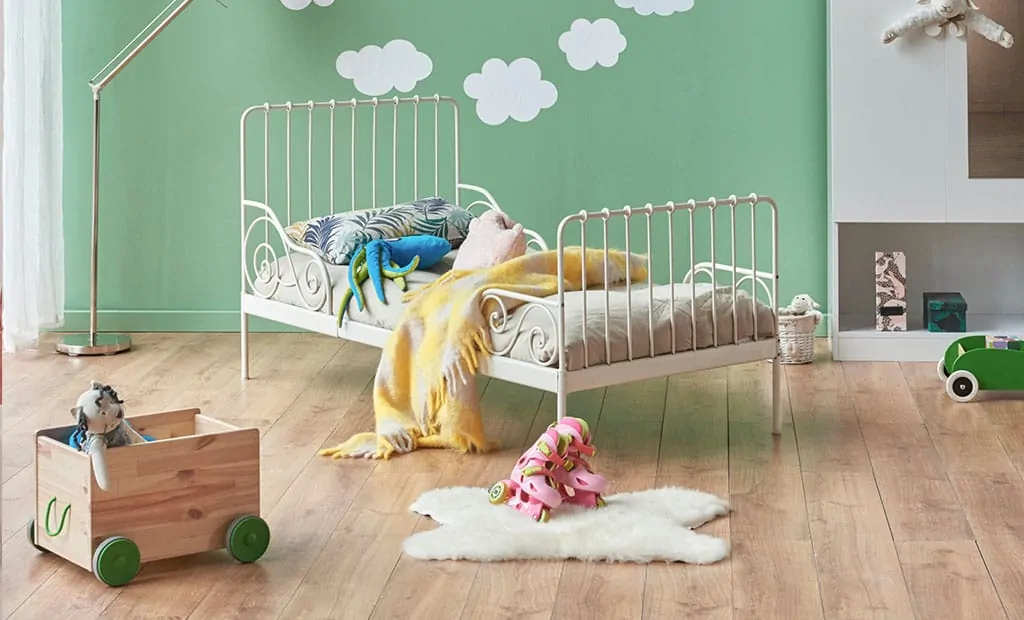
Platform Bed
When choosing a toddler platform bed, prioritize safety features like built-in guardrails and consider a lower bed height for easy access. Opt for a bed that complements your child’s interests and room decor while offering space-saving storage options. Lastly, consider beds that grow with your child to save money and effort in the long run.
- Age suitability: Platform beds for toddlers are typically suitable for children aged 2-5. However, this can vary depending on the child’s development and comfort level transitioning from a crib or toddler bed.
- Size and weight limits: Usually, these beds accommodate crib-sized or twin-sized mattresses, with weight limits ranging between 50-200 pounds.
Trundle Beds
Great for sleepovers or shared rooms, as they save space when not in use.
- Age suitability: Suitable for kids aged 3 years and older.
- Size and weight limits: Twin-sized bed with a second twin-sized bed that slides underneath. Weight limits vary depending on the bed frame and mattress.
I understand the challenge of picking the perfect bed size for your preschooler. To make your life easier, let me share some factors that helped me determine the best bed size for my little ones.
What Factors Determine the Best Bed Size for Preschoolers?
- Room size: This might sound obvious, but how often have I seen a small kid’s room with only a giant bed in it. Measure the space available to ensure the bed fits comfortably and leaves enough room for play and other furniture.
- Child’s growth: Kids grow quickly, so investing in a bed they can use for several years is smart. I prefer to buy a bigger bed that will last, instead of replacing it every few years.
- Safety: Preschoolers are big kids but don’t have full control over their movement yet. Therefore, Look for beds with safety features like guardrails to prevent falls during sleep.
- Functionality: Consider beds with built-in storage or space for sleepovers (e.g., trundle beds). Your kid might have many toys or clothing that take up a lot of space. Also, some children start having friends or cousins sleeping over around that age.
Your child’s comfort and safety are the top priorities. While finding a bed that saves you money is a bonus!
Moving forward, let’s tackle the school-age years.
School-Age Children – 6 to 12 years: The Golden Years
Children aged 6 years or more don’t need the safety features of the previous bed type. They don’t need a low-to-the-ground bed because they are tall enough and have the necessary mobility to go in-and-out of bed. Therefore, it’s around that age that parents consider space-saving solutions like a loft or bunk beds.
What Type of Bed is Suitable for Kids of 6 Years and up?
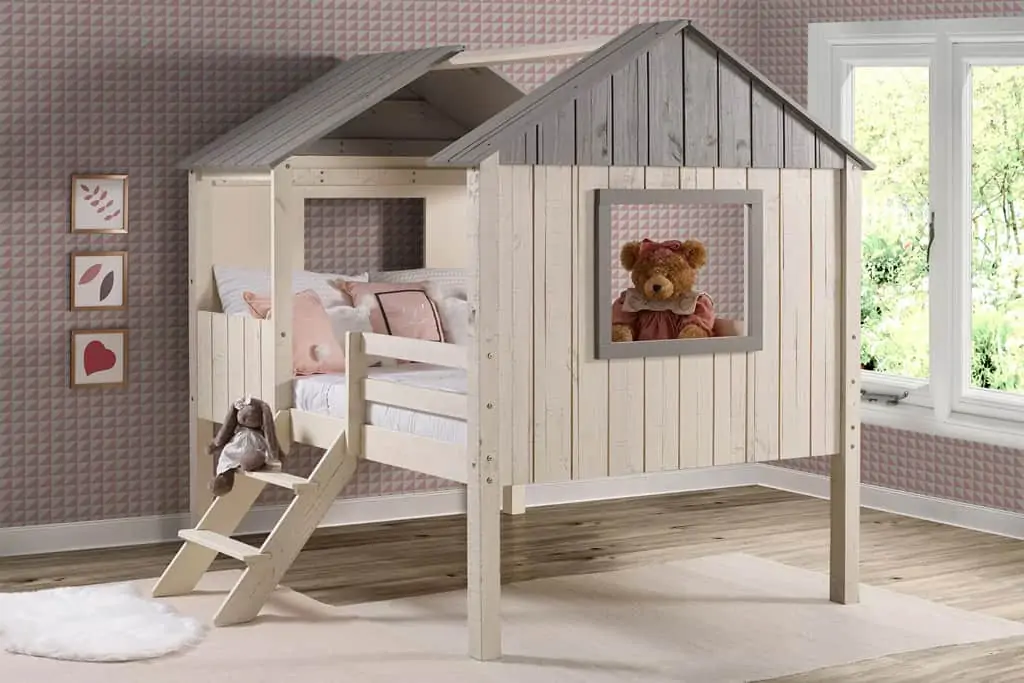
Bunk Bed
Bunk beds are a fantastic choice if you have more than one child sharing a room or your child loves having sleepovers. These beds come with two separate sleeping spaces stacked on each other, making the most of the vertical space in the room. Kids love bunk beds’ fun and adventure, and parents appreciate the space-saving design.
- Suitable age: Generally recommended for children aged 6 years and older, with the top bunk usually reserved for kids aged 6-12.
- Size and weight limits: Bunk beds come in various sizes, most being twin-sized. The weight limit for the top bunk typically ranges between 160-200 pounds, while the bottom bunk can hold around 200-250 pounds. Always check the manufacturer’s guidelines for specific weight limits.
For more information on bunk beds, check out this guide I created to help you choose the best bunk bed for your kid.
Loft Bed
On the other hand, Loft beds raise a single bed high off the ground, leaving room beneath for a desk, dresser, or play area. This bed type is perfect for children who need a dedicated space for homework or creative pursuits. With a loft bed, you can efficiently utilize the room’s floor space while providing your child a comfortable sleeping area.
- Suitable age: Recommended for children aged 6 years and older. Ensure your child can safely navigate the ladder or stairs.
- Size and weight limits: Loft beds are available in twin, full, and even queen sizes. Weight limits vary depending on the bed’s construction and materials, with most ranging from 200-250 pounds. Again, refer to the manufacturer’s guidelines for specific limits.
- Other factors: Consider the room’s layout and available space beneath the bed for furniture or play areas. Choose a loft bed with proper guardrails to ensure your child’s safety. Additionally, consider the ease of bed-making and whether your child can change the sheets independently.
For more information on loft beds, check out this guide I created to help you choose the best loft bed for your kid.
What size of Mattress is Suitable for School-Age Children
As a father of two, I know how important it is to find the right mattress size for our growing kids. School-age children need a comfortable and supportive mattress to ensure a good night’s sleep. But what size should you choose? Let’s dive in.
- Twin mattresses: They are the most common choice for school-age children. They measure 38 x 75 inches, providing enough space for most kids to sleep comfortably. The great thing about twin mattresses is that they can easily fit in bunk beds and loft beds, which are popular for this age group.
- Full-size mattresses: Measuring 54 x 75 inches, are another option for school-age kids, especially if they need more room to move around. They suit children who toss and turn a lot or have a larger body frame.
Remember, a well-rested child is happy, so investing in a good mattress can make a difference. One mom I talked to shared that her daughter’s new full-size bed helped reduce bedtime battles.
Now, let’s talk about the teenage years.
Teenagers – 13 to 19 years: Navigating the Teenage Terrain
Ah, teenagers. It’s a time of change, growth, and lots of sleep. A full or queen-size bed is ideal for teens, depending on their size and the room’s dimensions. You may even consider a king-size bed if space allows. My friend Dave said his son’s new queen bed was a game-changer, providing plenty of room for him to sprawl out and recharge for the next day.
What Bed Sizes Are Suitable for Teenagers?
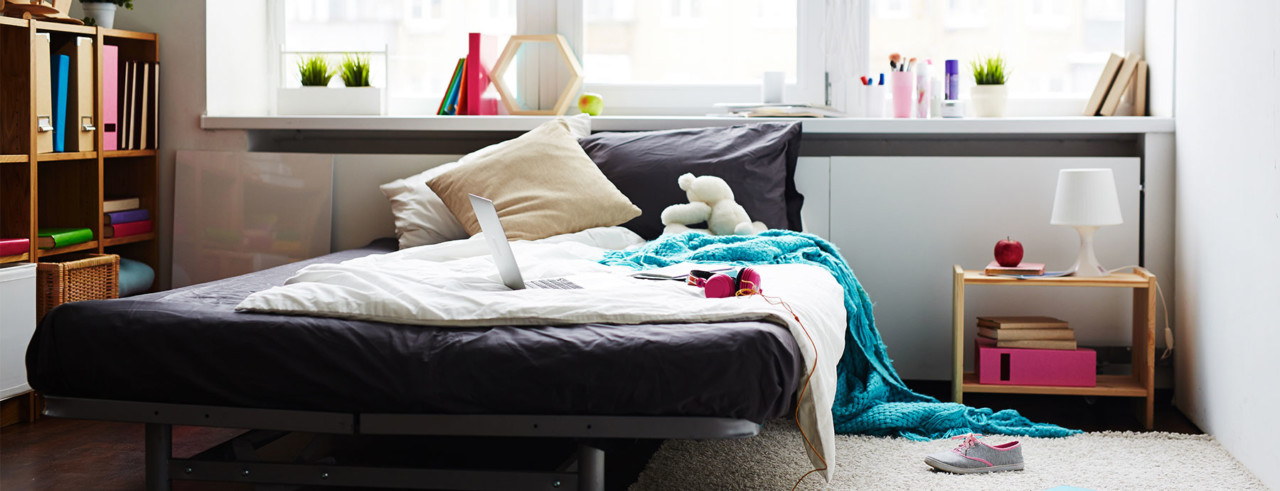
Full-Size Beds
Full-size beds are popular among teenagers because they provide more sleeping space than twin beds, making them more comfortable. They can accommodate a variety of sleeping positions and are suitable for single sleepers and sleepovers with friends. Additionally, full-size beds have a more mature feel, which appeals to teenagers who want to feel more grown-up.
- Suitable for: Ideal for average-sized teens, but taller ones might prefer more length.
- Size and weight limits: 54″ x 75″; no specific weight limit, but check the bed frame’s capacity.
Queen Beds
Queen beds offer even more comfort with extra sleeping space, making them a great choice for taller or larger teenagers who need additional length or width for a comfortable night’s sleep. They can also be seen as a luxury or status symbol, which some teenagers may find appealing.
- Suitable for: Requires a larger room, which is great for teens who move a lot while sleeping.
- Size and weight limits: 60″ x 80″; similar to full-size beds, check bed frame weight capacity
Loft Beds
Loft beds are an excellent choice for teenagers, especially those with limited bedroom space. By utilizing vertical rooms, loft beds maximize floor space and create personalized spaces beneath the bed, such as a study nook, lounge area, or additional storage. This gives teenagers their own unique space to relax and unwind. Furthermore, loft beds offer a fun and unique sleeping experience, adding a touch of excitement to bedtime.
- Suitable age: 13-17; ensure your teen is comfortable with the height
- Size and weight limits: Twin or full mattress; weight limit depends on the bed frame (usually 200-300 lbs)
For more information on loft beds, check out this guide I created to help you choose the best beds with desk underneath for your kid.
How Can Bed Size Affect the Well-Being of Your Teenager?
Teenagers are growing and need enough room to stretch out and sleep comfortably. A cramped bed may lead to poor sleep quality, affecting their physical and mental health. Investing in a larger mattress can greatly affect their sleep quality and mood.
Research shows that sleep is essential for teenagers’ growth, development, and well-being. A well-fitted bed can help prevent sleep disturbances and support healthy sleep patterns.
When choosing the best bed size for your teenager, consider their height, growth potential, and any sleep issues they may have. A larger bed can support them for restful sleep and contribute to their overall well-being.
Lastly, don’t forget about style! Teenagers want a bed that reflects their personality and interests. A comfortable, stylish bed can make their room feel like their sanctuary, promoting relaxation and a sense of ownership.
Conclusion: The Final Word
As a father of two, I understand our challenges when choosing the perfect bed size for our growing kids. Each child is unique, and their needs may change over time. That’s why I keep an open mind and be prepared to adjust my choices as they grow.
After all, there’s nothing better than tucking our little monkeys (and not-so-little) into a cozy bed at the end of the day.
Happy bed hunting!
In general, kid’s beds don’t come with a mattress, and you should consider ordering one at the same time as the bed. Don’t worry, I have simplified the selection by creating this list of the best mattress for kid’s beds. Or perhaps you need help, and you should visit this guide I made on choosing the ideal mattress for your baby crib.
Still unsure about the bed? Here’s some other style of bed you should also consider for your kid’s room:

